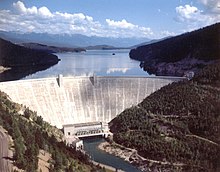Hungry Horse Dam
| Hungry Horse Dam | |
|---|---|
 |
|
|
Location of Hungry Horse Dam in Montana
|
|
| Location | Flathead County, near hungry horse, Montana, USA |
| Coordinates | 48°20′30″N 114°0′51″W / 48.34167°N 114.01417°WCoordinates: 48°20′30″N 114°0′51″W / 48.34167°N 114.01417°W |
| Construction began | April 21, 1948 |
| Opening date | July 18, 1953 |
| Operator(s) | U.S. Bureau of Reclamation |
| Dam and spillways | |
| Type of dam | Concrete thick arch dam |
| Impounds | South Fork Flathead River |
| Height | 564 ft (172 m) |
| Length | 2,115 ft (645 m) |
| Width (crest) | 34 feet (10 m) |
| Width (base) | 320 feet (98 m) |
| Dam volume | 2,934,500 cu yd (2,243,600 m3) |
| Spillway type | Gated Morning Glory |
| Spillway capacity | 50,000 cu ft/s (1,400 m3/s) |
| Reservoir | |
| Creates | Hungry Horse Reservoir |
| Total capacity | 3,467,179 acre feet (4.276702 km3) |
| Catchment area | 1,640 sq mi (4,200 km2) |
| Power station | |
| Type | Conventional |
| Hydraulic head | 520 ft (160 m) |
| Turbines | 4 x 107 MW Francis turbines |
| Installed capacity | 428 MW |
| Annual generation | 906,720,100 KWh (2007) |
Hungry Horse Dam is an arch dam on the South Fork Flathead River in the Rocky Mountains of the U.S. state of Montana. It is located in Flathead National Forest, in Flathead County, about 15 miles (24 km) south of the west entrance to Glacier National Park, 9 miles (14 km) southeast of Columbia Falls, and 20 miles (32 km) northeast of Kalispell. The Hungry Horse project, dam, and powerplant are operated by the United States Bureau of Reclamation. The entrance road leading to the dam is located in Hungry Horse, Montana.
At 564 feet (172 m) in height, the dam was the third largest and second highest concrete dam in the world at the time of its completion in 1953, with a volume of 3,100,000 cubic yards (2,400,000 m3). The dam's spillway is the highest morning glory structure in the world. The spillway is controlled by a 64-by-12-foot (19.5 by 3.7 m) ring gate.
Construction of Hungry Horse Dam was authorized by the Act of June 5, 1944 (58 Stat. 270, Public Law 78-329). Construction began in April 1948 and completed on July 16, 1953. The purposes of the Hungry Horse Project authorized by law are irrigation, flood control, navigation, streamflow regulation, hydroelectric generation, and other beneficial uses such as recreation. However, no irrigation facilities were built and the project has no irrigation obligations. Hydroelectric power generation is the primary purpose of the dam today. Flood control is the dam's other main purpose. The dam, reservoir, and surrounding area are used for recreation. However, the once great lower gorge (Montana's best whitewater) lies submerged underneath.
The project contributes to hydroelectric power generation not only at Hungry Horse Dam, but by storing and releasing water for use by downriver hydroelectric dams on the Flathead River, Clark Fork, Pend Oreille River, and Columbia River. About a billion kilowatt–hours are generated annually at Hungry Horse Dam, while in an average year the release water will generate about 4.6 billion kilowatt–hours of power as it passes through the series of downstream powerplants.
...
Wikipedia

